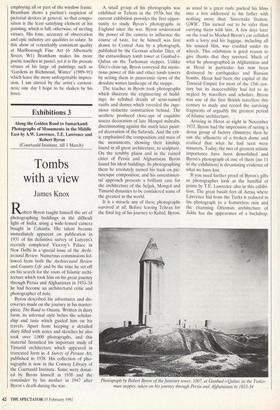Exhibitions 2
Sarah Raphael (Agnew's, till 6 March) Christopher Bramham (Marlborough Fine Art, till 29 February)
Stirred but not shaken
Giles Auty
During much of the year I see such a surfeit of art that I am amazed at how deprived I feel after just one month away from the gallery circuit. However, the small number of occasions on which I have been allowed out from medical house arrest have been deeply heartening ones.
The first was a trip to St James's Palace to hear the speech given by the Prince of Wales to mark the inauguration of the new Institute of Architecture which bears his name. It is not the easiest of things to rise on one's back legs and harangue a profes- sional audience, however pleasantly, on its collective shortcomings. Prince Charles spoke with visionary zeal about an acute human need for spiritual re-awakening and more lasting values. Much of what he said in this vein about architecture could be applied just as appropriately to the other visual arts. The values which inform his new Institute of Architecture would pro- vide a sound basis for the kind of tradition- al but revitalised art school I have been advocating for years. It would be gratifying to think the existence of the first might help bring the foundation of the latter measurably closer.
The other heartening events of the past fortnight have been a pair of exhibitions of unusual interest by artists still in their thir- ties. Both have reached their present posi- tions in spite of, rather than due to, the artistic climate which prevails. Probably the progress of both could have been accelerat- ed by better teaching and more reliable mentors, although Sarah Raphael was hardly short of popular acclaim from a rel- atively early age. But the progress I refer to is of a nature which is less easy to attain. It is to Sarah Raphael's credit that she is not seduced entirely by her early success. While the attractions of the great body of her work at Agnew's (43 Old Bond Street, WI) are relatively obvious, these do not coincide necessarily with its merits. The poetic poignancy of her landscapes and large figure paintings lies in the first cate- gory: stylised figures in triplicate chase squirrels or expose their pregnancy on a beach. There is a good deal of personal or indeed autobiographical symbolism here, and many believe this kind of thing makes excellent subject matter for significant painting. However, there is no guarantee that the particular will demonstrate any principle with wider application. Indeed, where it does not, as in a great deal of sur- realist painting, an aura of significance makes an inadequate mask for a basic superficiality. Sarah Raphael belongs squarely to the school of English romanti- cism because the impetus of her vision is primarily pastoral. Green, sometimes of a rather sharp variety, is much in evidence in her art. Form is simplified, not always entirely convincingly, in rather the same way as in works by that important but neglected artist Mario Sironi, who is anoth- er who gazes back admiringly to the Renaissance. At another level, Sarah Raphael paints small portraits and land- scapes straightforwardly. By strengthening her knowledge of the perceptual world, the artist can add fresh conviction to her forays into less tangible realms.
Where Sarah Raphael creates a poetry of the poignant, Bramham prefers a prose of the palpable. He seems driven by a fury of the will, rather than by the muse of imagi- nation. Even his choice of subject is a mat- ter for pragmatism. Looking out from the window of his studio at Richmond, Surrey, Bramham paints the back gardens below. This practice combines the advantages of painting direct from the subject with the solaces offered by coffee and central heat- ing, roof and radio. I for one need no con- vincing of the benefits of this genre. Lucian Freud has painted some notable town- scapes in this fashion and, like Bramham, abjures the compositional temptations of 'Gardens in Richmond, Winter', 1989-91, by Christopher Bramham employing all or part of the window frame. Bramham shows a puritan's suspicion of pictorial devices in general, so that compo- sition is the least satisfying element of his painting, which is full, otherwise, of sterling virtues. His tone, accuracy of observation and epic industry are qualities to salute. In this show of remarkably consistent quality at Marlborough Fine Art (6 Albemarle Street, W1) Bramham makes his more poetic touches in pastel, yet it is the prosaic virtues of his large oil paintings such as `Gardens in Richmond, Winter' (1989-91) which leave the more unforgettable impres- sion. I am stirred by the artist's earnest- ness; one day I hope to be shaken by his force.



























































 Previous page
Previous page